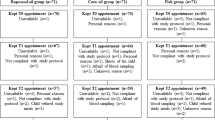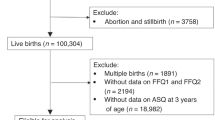Abstract
Background:
An appropriate supply of n-3 long-chain polyunsaturated fatty acids (LC-PUFAs) during early childhood may enhance cognitive development. Little attention is paid to the fatty acid (FA) supply during the complementary feeding period. We examined the polyunsaturated fatty acids (PUFAs) and LC-PUFAs pattern in dietary practice of two study groups and evaluated the results against the present Dietary Guidelines in Germany.
Methods:
The food consumption and FA pattern of dietary practice in subjects from two prospective studies (n=102 and n=184, respectively) at the age of 3, 6 and 9 months was assessed by weighed diet records, and changes during the first year of life were compared with the food-based dietary guidelines for the first year of life.
Results:
Dietary practice in the complementary feeding period was clearly dominated by commercial food products. The FA composition in dietary practice was different from the Guideline Diet and the ratio of n-6/n-3 PUFAs was less favorable. Consumption of breast milk or formula was still of major importance for the intake of LC-PUFAs in the complementary feeding period.
Conclusion:
LC-PUFAs are predominantly provided by breast milk and formula during the first year of life and consequently decrease when milk consumption decreases. For compensation, commercial complementary food might come closer to the Guideline Diet by lowering the n-6/n-3 PUFA ratio through appropriate vegetable oil along with an increase in total fat content up to the legal limit.
This is a preview of subscription content, access via your institution
Access options
Subscribe to this journal
Receive 12 print issues and online access
$259.00 per year
only $21.58 per issue
Buy this article
- Purchase on Springer Link
- Instant access to full article PDF
Prices may be subject to local taxes which are calculated during checkout


Similar content being viewed by others
References
Aggett PJ, Haschke F, Heine W, Hernell O, Koletzko B, Lafeber H et al. (1994). Committee report: childhood diet and prevention of coronary heart disease. ESPGAN Committee on Nutrition. European Society of Pediatric Gastroenterology and Nutrition. J Pediatr Gastroenterol Nutr 19, 261–269.
Agostoni C, Decsi T, Fewtrell M, Goulet O, Kolacek S, Koletzko B et al. (2008). Complementary feeding: a commentary by the ESPGHAN Committee on Nutrition. J Pediatr Gastroenterol Nutr 46, 99–110.
Agostoni C, Zuccotti GV, Radaelli G, Besana R, Podesta A, Sterpa A et al. (2009). Docosahexaenoic acid supplementation and time at achievement of gross motor milestones in healthy infants: a randomized, prospective, double-blind, placebo-controlled trial. Am J Clin Nutr 89, 64–70.
Alexy U (2007). Die Ernährung des gesunden Säuglings. Ernährungs-Umschau 10/07, 588–594.
Carnielli VP, Simonato M, Verlato G, Luijendijk I, De Curtis M, Sauer PJJ et al. (2007). Synthesis of long-chain polyunsaturated fatty acids in preterm newborns fed formula with long-chain polyunsaturated fatty acids. Am J Clin Nutr 86, 1323–1330.
Commission Directive 2006/125/EG DER KOMMISSION vom 5. Dezember 2006 über Getreidebeikost und andere Beikost für Säuglinge und Kleinkinder. In: European Union (ed). Amtsblatt der Europäischen Union, (2006) Vol L 339/16, pp 16–35.
DGE (2000). Referenzwerte für die Nährstoffzufuhr. Umschau-Braus: Frankfurt.
Hoffman DR, Theuer RC, Castaneda YS, Wheaton DH, Bosworth RG, O'Connor AR et al. (2004). Maturation of visual acuity is accelerated in breast-fed term infants fed baby food containing DHA-enriched egg yolk. J Nutr 134, 2307–2313.
Innis SM (2003). Perinatal biochemistry and physiology of long-chain polyunsaturated fatty acids. J Pediatr 143, S1–S8.
Kersting M (2001). Ernährung des gesunden Säuglings-Lebensmittel-und mahlzeitenbezogene Empfehlungen. Monatsschr Kinderheilkd 149, 4–10.
Kersting M, Dulon M (2002). Assessment of breast-feeding promotion in hospitals and follow-up survey of mother-infant pairs in Germany: the SuSe Study. Public Health Nutr 5, 547–552.
Koletzko B (1999). Response to and range of acceptable fat intakes in infants and children. Eur J Clin Nutr 53 (Suppl 1), S78–S83.
Kroke A, Manz F, Kersting M, Remer T, Sichert-Hellert W, Alexy U et al. (2004). The DONALD Study. History, current status and future perspectives. Eur J Nutr 43, 45–54.
Luukkainen P, Salo MK, Visakorpi JK, Raiha NC, Nikkari T (1996). Impact of solid food on plasma arachidonic and docosahexaenoic acid status of term infants at 8 months of age. J Pediatr Gastroenterol Nutr 23, 229–234.
Makrides M, Hawkes JS, Neumann MA, Gibson RA (2002). Nutritional effect of including egg yolk in the weaning diet of breast-fed and formula-fed infants: a randomized controlled trial. Am J Clin Nutr 75, 1084–1092.
Michaelsen KF (2005). What is known? Short-term and long-term effects of complementary feeding. In: Schmitz HO (ed). Feeding during Late Infancy and Early Childhood: Impact on Health. Vevey/S Karger AG: Basel. Vol. 56, pp 185–205.
Sauerwald TU, Hachey DL, Jensen CL, Heird WC (1997). New insights into the metabolism of long chain polyunsaturated fatty acids during infancy. Eur J Med Res 2, 88–92.
Schwartz J, Dube K, Sichert-Hellert W, Kannenberg F, Kunz C, Kalhoff H et al. (2009). Modification of dietary PUFA via complementary food enhances n-3 LC-PUFA synthesis in healthy infants—a double blinded randomized controlled trial. Arch Dis Child 94, 876–882.
Sichert-Hellert W, Kersting M, Chada C, Schäfer R, Kroke A (2007). German food composition database for dietary evaluations in children and adolescents. J Food Compost Anal 20, 63–70.
Simopoulos AP (2003). Importance of the ratio of omega-6/omega-3 essential fatty acids: evolutionary aspects. In: Simopoulos AP and Cleland LG (eds). Omega-6/Omega-3 Essential Fatty Acid Ratio: The Scientific Evidence. World Rev Nutr Diet, Basel: Karger. Vol. 92, pp 1–22.
Souci SW, Fachmann W, Kraut H (2000). Die Zusammensetzung der Lebensmittel Nährwert-Tabellen. Medpharm Scientific Publishers: Stuttgart.
Svahn JC, Feldl F, Raiha NC, Koletzko B, Axelsson IE (2000). Fatty acid content of plasma lipid fractions, blood lipids, and apolipoproteins in children fed milk products containing different quantity and quality of fat. J Pediatr Gastroenterol Nutr 31, 152–161.
Svahn JC, Feldl F, Raiha NC, Koletzko B, Axelsson IE (2002). Different quantities and quality of fat in milk products given to young children: effects on long chain polyunsaturated fatty acids and trans fatty acids in plasma. Acta Paediatr 91, 20–29.
Uauy R, Mena P, Wegher B, Nieto S, Salem Jr N (2000). Long chain polyunsaturated fatty acid formation in neonates: effect of gestational age and intrauterine growth. Pediatr Res 47, 127–135.
Uauy R, Rojas C, Llanos A, Mena P (2005). Dietary essential fatty acids in early postnatal life: long-term outcomes. Nestle Nutr Workshop Ser Pediatr Program 55, 101–136.
Acknowledgements
The DINO study was funded by the Central Marketing Organization of German Agricultural Economics (CMA), Union for the Promotion of Oil and Protein Plants (UFOP), Brökelmann & Co, Oil mill GmbH & Co, North German Seeds Group AG Georg Lembke. The DINO study food was provided by Hipp GmbH & Co, Vertrieb KG and Nestlé Nutrition GmbH.
Author information
Authors and Affiliations
Corresponding author
Additional information
Guarantor: J Schwartz.
Contributors: MK and HK contributed in designing of the DINO study; KD and JS contributed in conduction of the DINO study and data collection; UA contributed in construction of the DONALD study and the Guideline Diet; JS contributed in data analysis; JS and MK contributed in writing the paper; MK and HK supervised the study.
Rights and permissions
About this article
Cite this article
Schwartz, J., Dube, K., Alexy, U. et al. PUFA and LC-PUFA intake during the first year of life: can dietary practice achieve a guideline diet?. Eur J Clin Nutr 64, 124–130 (2010). https://doi.org/10.1038/ejcn.2009.123
Received:
Revised:
Accepted:
Published:
Issue Date:
DOI: https://doi.org/10.1038/ejcn.2009.123
Keywords
This article is cited by
-
Food, water, energy, and macronutrient intake of non-breastfed infants and young children (0–3 years)
European Journal of Nutrition (2020)
-
Fatty acid supply with complementary foods and LC-PUFA status in healthy infants: results of a randomised controlled trial
European Journal of Nutrition (2016)
-
Fish and rapeseed oil consumption in infants and mothers: dietary habits and determinants in a nationwide sample in Germany
European Journal of Nutrition (2015)
-
Complementary Feeding: Critical Considerations to Optimize Growth, Nutrition, and Feeding Behavior
Current Pediatrics Reports (2013)



